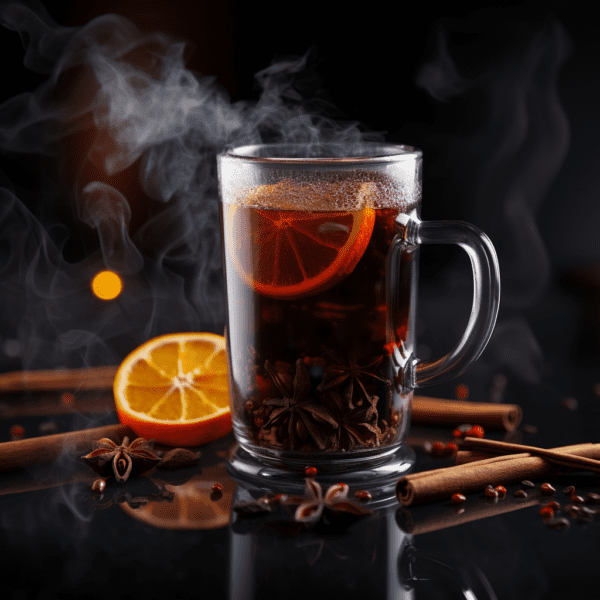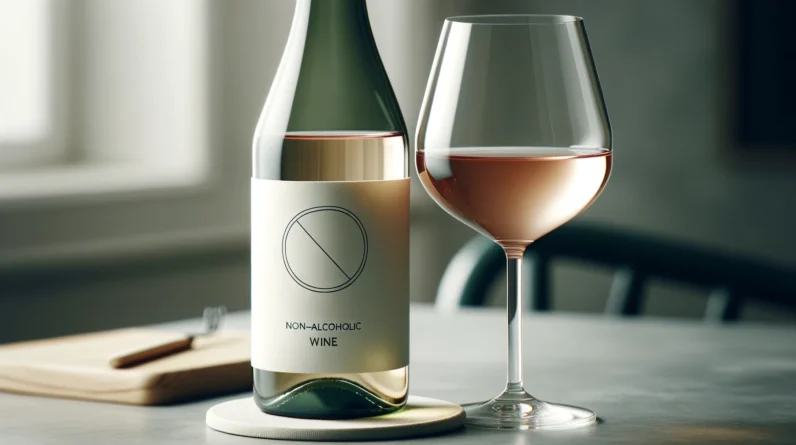
Picture yourself on a chilly winter evening.
You’re outside, and with every exhale, your breath forms delicate clouds in the crisp air.
In your hands, there’s no ordinary drink—it’s a steaming mug of mulled wine.
This isn’t just a beverage; it’s an experience, a sensory journey that wraps you in warmth from the inside out.
As the days get shorter and the cold tightens its grip, mulled wine takes center stage.
It’s the undisputed hero of the season—the drink of choice for festive gatherings, holiday celebrations, or those serene nights by the fireplace.
Right here, in the world of wine enthusiasts, we’re delving deep.
We’re uncovering the rich history, the symphony of aromatic spices, and the artistry behind crafting the perfect mulled wine.
So, come along on this flavorful expedition through time and taste.
We’re about to reveal the secrets of creating exquisite mulled wine recipes, tailor-made for the coziest winter moments.
Ready to dive in?

The history of mulled wine
Let’s embark on a time-travel journey back to the glory days of ancient Rome, where the epic tale of mulled wine begins.
Imagine this: wine, a daily staple, but seldom served with a fiery embrace.
Yet, the savvy Romans, with their penchant for indulgence, were quick to recognize the enchantment of warming wine, infused with a symphony of spices.
Picture battle-hardened soldiers, returning from frigid campaigns, seeking refuge in this elixir.
They weren’t merely tossing spices and herbs haphazardly; they did it for the exhilarating flavors and the whispered promises of medicinal benefits.
As the Roman Empire stretched its mighty arms, so did the art of mulled wine.
It traversed the uncharted realms of Europe, each corner adding its own unique twist to the enchanted recipe.
Now, leap ahead to medieval Europe, where mulled wine evolved into a symbol of boundless hospitality and the life of the party.
Fast forward to Victorian England, where mulled wine made an awe-inspiring resurgence, capturing hearts during grand holiday soirées.
It even nestled itself deep within Christmas traditions, carving a special place at the bustling Christmas markets.
Now, in the modern era, mulled wine stands as a cherished winter elixir, savored worldwide.
Its history? A triumphant testament to the unwavering allure of warmth, spice, and age-old traditions, boldly challenging winter’s icy grip.

Unlocking the Art of Crafting Perfect Mulled Wine
Listen up, wine lovers!
Crafting the perfect mulled wine isn’t just a recipe; it’s an art form.
It’s about taking a simple bottle of wine and transforming it into a symphony of flavors that dance on your palate.
The Essentials
First, you need a solid foundation—quality wine.
Reds like Cabernet Sauvignon or Merlot bring depth, but don’t shy away from experimenting with white wines like Sauvignon Blanc for a lighter touch.
Opt for a budget-friendly red wine.
The spices and other ingredients will contribute to the flavor, so the wine’s nuances matter less.
Spices and Aromatics
Now, it’s time to unleash the spices.
Cloves, cinnamon sticks, star anise—they’re the maestros in this orchestra.
The symphony also includes zesty citrus slices and sweeteners like honey or sugar to create a perfect balance.
Use fresh citrus slices, such as oranges and lemons, to add brightness and a zesty kick to your mulled wine.
Use sweeteners like honey, sugar, or maple syrup to balance the wine’s acidity and tannins. Adjust the sweetness to your taste.
The Heat
But here’s the kicker: it’s not a boiling cauldron; it’s a gentle simmer.
Heat, but don’t overheat.
You want those flavors to mingle, not brawl. Give it a good 15-20 minutes to reach its crescendo.
This time allows the spices and aromatics to infuse the wine, masking any shortcomings of the wine itself.
The Secret Ingredient: Love
Now, let’s talk about the secret ingredient—love.
Yes, that’s right.
The warmth you infuse comes from your passion for the craft.
It’s in the way you stir, the way you choose your spices, the anticipation as you wait for it to meld.

Can Everyone Get It?
Absolutely!
Crafting the perfect mulled wine isn’t reserved for sommeliers or top chefs.
It’s a journey anyone can embark upon.
All it takes is a sense of adventure and the willingness to experiment.
The Perfect Mulled Wine
So, what is the perfect mulled wine?
It’s a potion that warms your soul on the coldest of nights, a concoction that brings people together, and a taste that lingers in your memory.
It’s an experience—a sensory symphony that combines the familiar comfort of wine with the thrilling spice of the season.
It’s a masterpiece, and you’re the artist.
Go on, create your masterpiece, and share it with the world.
Top 5 Mulled Wine Recipes for Winter
1. Classic Mulled Wine
- Ingredients:
- 1 bottle of red wine (Cabernet Sauvignon or Merlot works well)
- 1/4 cup of brandy
- 1/4 cup of honey or sugar (adjust to taste)
- 1 orange (sliced)
- 8-10 whole cloves
- 2 cinnamon sticks
- 2-star anise
- Optional: citrus zest for garnish
- Instructions:
- Combine all ingredients in a large saucepan.
- Heat gently over low-medium heat, avoiding boiling.
- Let it simmer for 15-20 minutes, allowing flavors to meld.
- Strain and serve hot in mugs. Garnish with citrus zest if desired.
2. Spiced Mulled Wine
- Ingredients:
- 1 bottle of red wine (Zinfandel or Shiraz works well)
- 1/2 cup of spiced rum
- 1/4 cup of brown sugar
- 1 orange (sliced)
- 5-6 whole cloves
- 3 cardamom pods
- 2 cinnamon sticks
- 1-inch fresh ginger (sliced)
- Instructions:
- Combine all ingredients in a large pot.
- Heat gently without boiling, stirring to dissolve sugar.
- Simmer for 20-25 minutes to infuse flavors.
- Strain and serve warm in mugs.
3. White Mulled Wine
- Ingredients:
- 1 bottle of white wine (Sauvignon Blanc or Pinot Grigio)
- 1/4 cup of elderflower liqueur
- 1/4 cup of honey
- 1 lemon (sliced)
- 4-5 cardamom pods
- 2 cinnamon sticks
- A few fresh mint leaves for garnish
- Instructions:
- Combine all ingredients in a saucepan.
- Heat gently, avoiding boiling, until honey dissolves.
- Let it steep for 15-20 minutes.
- Strain and serve in white wine glasses. Garnish with mint leaves.
4. Cranberry Mulled Wine
- Ingredients:
- 1 bottle of red wine (Malbec or Cabernet Sauvignon)
- 1/2 cup of cranberry juice
- 1/4 cup of cranberries (fresh or frozen)
- 1/4 cup of maple syrup
- 1 orange (sliced)
- 4-5 cloves
- 2 cinnamon sticks
- Instructions:
- Combine all ingredients in a pot.
- Heat gently until cranberries soften and flavors meld (about 15 minutes).
- Strain and serve in mugs.
5. Non-Alcoholic Mulled “Cider” Wine
- Ingredients:
- 4 cups of apple cider
- 1/2 cup of orange juice
- 1/4 cup of honey
- 1 orange (sliced)
- 8-10 whole cloves
- 3 cinnamon sticks
- 2 star anise
- Instructions:
- Combine all ingredients in a saucepan.
- Heat gently until steaming (do not boil).
- Simmer for 10-15 minutes.
- Strain and serve in mugs. This version is alcohol-free and family-friendly.
These mulled wine recipes offer a delightful range of flavors and can cater to different preferences.

Why Mulled Wine is So Popular in Winter Season?
Mulled wine’s popularity during the winter season can be attributed to several factors, making it a beloved beverage choice for cold weather and holiday gatherings.
Warmth and Comfort
One of the most apparent reasons is that mulled wine is served warm.
During the winter months, people seek warmth and comfort in their food and beverages.
The steam rising from a cup of mulled wine not only warms the body but also creates a cozy atmosphere.
Spices and Aromatics
Mulled wine is infused with spices like cloves, cinnamon, and star anise, as well as citrus fruits like oranges.
These aromatic ingredients not only enhance the flavor but also fill the air with a delightful scent.
The combination of warmth and enticing aromas adds to the overall winter experience.
Holiday Tradition
Mulled wine has become a holiday tradition in many cultures.
It’s often associated with festive celebrations, such as Christmas markets in Europe or holiday parties.
Serving mulled wine can evoke a sense of tradition and nostalgia during the winter season.
Seasonal Ingredients
Many of the ingredients used in mulled wine, such as citrus fruits and spices, are readily available during the winter months.
This makes it a convenient and cost-effective beverage option for both home cooks and hospitality establishments.
Taste and Flavor
Mulled wine’s flavor profile is well-suited to winter.
The combination of red wine, spices, and sweeteners creates a rich and comforting taste that complements hearty winter dishes.
It’s both soothing and flavorful, making it an ideal choice for sipping by the fireplace or with a holiday meal.
Social and Festive Atmosphere
Winter is a time for social gatherings, family get-togethers, and holiday parties.
Mulled wine’s association with warmth and togetherness makes it a symbol of conviviality.
It’s often shared among friends and loved ones, adding to the festive spirit of the season.
Adaptability
Mulled wine is versatile and can be adapted to suit different tastes and dietary preferences.
It can be made with red or white wine, alcoholic or non-alcoholic versions, and customized with various spices and sweeteners.
This adaptability allows it to appeal to a wide range of people.

In summary, mulled wine’s popularity in winter is a combination of its warming qualities, enticing flavors, cultural traditions, and the festive ambiance it creates.
It has become an integral part of winter celebrations and a cherished beverage that brings people together during the coldest months of the year.
FAQs:
Q1: What is mulled wine?
A1: Mulled wine is a warm and spiced wine typically made by heating red or white wine with various spices, citrus fruits, and sweeteners.
Q2: Where did mulled wine originate?
A2: Mulled wine traces its roots to ancient Rome, where it was enjoyed for its warming properties by soldiers and travelers.
Q3: What spices are commonly used in mulled wine?
A3: Common spices include cloves, cinnamon, star anise, and sometimes cardamom.
The choice of spices can vary based on personal preference.
Q4: Can I make non-alcoholic mulled wine?
A4: Yes, you can make non-alcoholic mulled wine by substituting wine with grape juice or apple cider.
It’s equally delicious and family-friendly.
Q5: What type of wine is best for mulled wine?
A5: For red mulled wine, use a robust wine like Cabernet Sauvignon.
For white, go for a dry wine such as Sauvignon Blanc.
Q6: How long should I simmer mulled wine?
A6: Simmer for about 15-20 minutes.
Avoid boiling, as it can evaporate the alcohol and affect the flavor.
Q7: Can I make mulled wine in advance?
A7: Yes, you can prepare the base mixture in advance and reheat it when needed.
Just add fresh citrus slices before serving.
Q8: What are some creative variations of mulled wine?
A8: Get creative with additions like brandy, elderflower liqueur, or even cranberry juice to add unique flavors.
Q9: What are good garnishes for mulled wine?
A9: Garnish with citrus zest, fresh mint leaves, or a cinnamon stick for added visual appeal and aroma.
Q10: Is mulled wine only for winter?
A10: While it’s most popular in winter, you can enjoy mulled wine year-round.
Experiment with seasonal variations to suit different occasions.
Resources:







